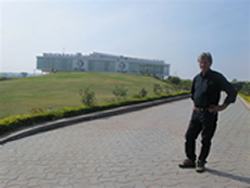 ‘Travelling on the Pune- Solapur highway, devoid of dividers most of the way, one overtakes hundreds of sugar-cane carrying carts that slow down the traffic and are a hazard but the locals seem to be quite used to the sight. ‘This is the cane growing season since Diwali and would go on till March- the growers are on their way to offload their cash crop to the sugar mills,’ the driver tells me. ‘Travelling on the Pune- Solapur highway, devoid of dividers most of the way, one overtakes hundreds of sugar-cane carrying carts that slow down the traffic and are a hazard but the locals seem to be quite used to the sight. ‘This is the cane growing season since Diwali and would go on till March- the growers are on their way to offload their cash crop to the sugar mills,’ the driver tells me.
The road gets narrower and the number of carts seems to increase as one turns off the highway onto Akluj, a small town about 40 kms. inside. Covering the last 15 kms of tight stretch suddenly ends in a beautiful modern building in the village of Motewadi, that is Fratelli winery with a glass façade and a beautiful guest house the ground floor of which doubles up as the reception, office and the tasting area.
Arjun Mohite-Patil, the local Indian partner is waiting at the reception with his charming wife, with a Maharashtra turban and the traditional ‘tikka’ to 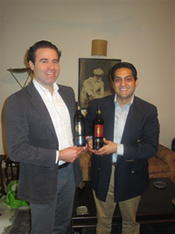 welcome me. It takes only a few minutes to realise that he is a down-to-earth, humble and warm and welcoming person-another one of the ‘satta’ –the seven partners. His cousin Ranjit Mohite-Patil , currently the Rajya Sabha MP is one of the fratelli (brothers) partners- the other two duos being Alessio-Andrea Secci from Tuscany and Kapil and Gaurav Sekhri from Delhi. welcome me. It takes only a few minutes to realise that he is a down-to-earth, humble and warm and welcoming person-another one of the ‘satta’ –the seven partners. His cousin Ranjit Mohite-Patil , currently the Rajya Sabha MP is one of the fratelli (brothers) partners- the other two duos being Alessio-Andrea Secci from Tuscany and Kapil and Gaurav Sekhri from Delhi.
Bound by mutual ties
Every wine must have a story to tell and Fratelli Wines has a fascinating story with a plot that links Delhi, Akluj in Maharashtra and Tavarnelle in the Chianti region, 25 kms south of Florence in the Tuscan province of the same name.
The genesis of the 4 year- old project near the sugar-cane and banana growing town of Akluj in District Solapur, 170 kms and 3.5 hours (4 hours during the cane season) from Pune lies in the export business of Delhi - based Bhupinder Sekhri, father of the Sekhri fratelli, who had been dealing for three decades with the senior Secci living in the Tuscan town of Tavarnelle, 30 kms from Florence. Kapil Sekhri met him as their business associate after finishing his college in UK and developed a good personal rapport with him.
The Maharashtra Wine Policy 2001 encouraged several dreamers with money in their pocket to get into wine production. Kapil and the Senior Secci dreamt of setting up a winery in Maharashtra. One of the family businesses of selling tar and bitumen in Maharashtra brought the young and suave Kapil in touch with the then Dy-CM and PWD minister of Maharashtra, Mr. Vijaysinhji Mohite-Patil. Ranjeet is his son who is also a politician, currently in Rajya Sabha, with whom he became quite friendly. Convincing the affluent Mohite-Patils to join hands was not very difficult. As Arjun tells me with no airs, Kapil convinced his affluent cousin that despite the money and local fame, the family was not known beyond the district. Wine business would get them the glamour and fame outside their limited circles.
Enter Masi
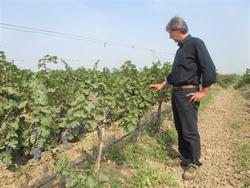 He was not wrong-today visits to the winery and regular coverage in the media have become almost a daily affair and one can tell that the Fratelli clan enjoys it. Making it possible has been Piero Masi, the Tuscan winemaker who has been involved with the project since inception and who has been single-handedly responsible for the technicals at the winery including quality that has the potential of becoming the industry benchmark. Being from the same town Tavarnelle Val di Pesa, where he also owns a small winery and several recognized labels to his credit, it was natural for the promoters to come to terms with him as their chief winemaker and enologist-but not before he visited India a couple of times and did the soil tests, studied the climate charts and weather patterns and concluded that certain barren patches amongst the fertile fields would be perfect for vines even though it might take lots of efforts and money to convert the land into vineyard. He was not wrong-today visits to the winery and regular coverage in the media have become almost a daily affair and one can tell that the Fratelli clan enjoys it. Making it possible has been Piero Masi, the Tuscan winemaker who has been involved with the project since inception and who has been single-handedly responsible for the technicals at the winery including quality that has the potential of becoming the industry benchmark. Being from the same town Tavarnelle Val di Pesa, where he also owns a small winery and several recognized labels to his credit, it was natural for the promoters to come to terms with him as their chief winemaker and enologist-but not before he visited India a couple of times and did the soil tests, studied the climate charts and weather patterns and concluded that certain barren patches amongst the fertile fields would be perfect for vines even though it might take lots of efforts and money to convert the land into vineyard.
Jungle may mangal
Time, effort and money it did take. The 50 acre- land in Motewadi where the winery is located, was bought in 2007 at around Rs.50,000 an acre, the 140 acres the company bought the next year at another site around 10 km away (where Arjun bought 10 acres in his personal capacity to sell grapes to the winery at around the same price) but around Rs.20 crores (Rs.200 million) have been spent on developing the land alone -using dynamite to cut into the rocky soil, make it undulating and rolling and carve out rows of channels to plant vines at the distance of 2.4 m*1m or 1600 plants per acre, explains Piero. The water shortage problem had to be sorted out by laying an 8 inch PVC pipe from canal to their tanks- traversing a distance of 3.5 kms. Drip irrigation with two pipes for every plant, is adequate as water source. Interestingly, the three Italian partners have no stake in the vineyards but only in the winery. Maharashtra agricultural laws allow Indians to own 50 acres of barren land or 17 acres of irrigated land but a company is a separate entity. Piero has advised and even supervised the development at both the Motewadi and Garwad village vineyards a total of 240 acres of which are now owned by the company, explains Arjun.
Interestingly, the political clout of the family may be gauged by the fact that the 140 acres bought by the company in Garwad was out of a total uncultivated land of 600 acres owned by about 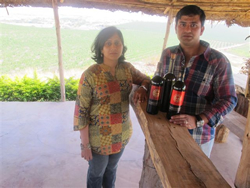 100 farmers who did not even know the location of the land. The Mohite-Patil family got them together , invited the government officials to the site and had the whole land demarcated, says Arjun sitting in the small thatched hut while showing me the vineyards at the unpopulated Garwad. It is built on a beautiful plateau created on the small patch of hill overlooking vines planted on slopes on both sides. The hut has a cemented floor and an open view in all directions that makes it a dream spot for wine picnics over a nice-weather weekend, with wind blowing all day long and a 360° panoramic view, explains Arjun. 100 farmers who did not even know the location of the land. The Mohite-Patil family got them together , invited the government officials to the site and had the whole land demarcated, says Arjun sitting in the small thatched hut while showing me the vineyards at the unpopulated Garwad. It is built on a beautiful plateau created on the small patch of hill overlooking vines planted on slopes on both sides. The hut has a cemented floor and an open view in all directions that makes it a dream spot for wine picnics over a nice-weather weekend, with wind blowing all day long and a 360° panoramic view, explains Arjun.
The eating grapes were already being grown in this area when Fratelli arrived but there were no vines. The land was bought after the fratelli decided to join hands. Though 3 duos are the main partners, Piero was given the option of being paid in cash or in shares as barter in lieu of the long term consultancy- he could be given a small slice from each set of partners holding equal shares. He chose the latter with a sound reason-his son is growing up and studying enology and so this project could be a long term prospect for him in the long term. It also reflects his long term vision about the quality of wine that the winery is capable of producing.
The long term approach has really helped Fratelli to gun for the top quality from day one. Having worked as the estate manager with the reputed Chianti Classico producer Isole e Olena-Piero has had decades of experience as a winemaker and viticulturist which he uses judiciously at Fratelli. He imported 330,000 saplings of 13 grape varieties including Chardonnay, Pinot Noir, Sangiovese, Syrah (Shiraz) and Marsanne white from South of France and Müller Thurgau besides the usual Cabernet Sauvignon, Cabernet Franc, Merlot, Chenin, Sauvignon Blanc and Gewürztraminer -all from a well known French nursery Guillaume- including Sangiovese. But why French Guillaume for Italian Sangiovese, I ask? ‘The plant saplings are the backbone of a good vineyard. If you start with a poor quality sapling or a clone, you will never have a good plant and subsequently the fruit. I have dealt with them for decades and they are highly reputed. They deal with all types of grape varieties including Italian,’ he says, explaining that any clone of Sangiovese including the Brunello may be imported from this nursery, but the grape will take the character based on the soil and local climate and will not be a Brunello.
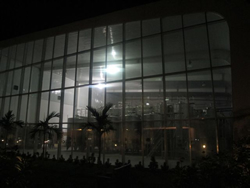 Quite adventurous and always willing to experiment, he planted around 4 acres plot with Pinot Noir which he had to uproot recently because it would not grow, bringing the efforts and investment in it to a naught. ‘I know Pinot nero needs a cooler climate but unless one tries one can never be fully sure,’ he says. He has replaced it with newer vines. Part of the vineyard has been left unused as he has not yet decided what to grow. He has also been bold enough to grow ungrafted saplings of Sauvignon Blanc in a small portion. He feels that there is no immediate risk of phylloxera in this area and if he is successful, the fruit will be of better quality. Quite adventurous and always willing to experiment, he planted around 4 acres plot with Pinot Noir which he had to uproot recently because it would not grow, bringing the efforts and investment in it to a naught. ‘I know Pinot nero needs a cooler climate but unless one tries one can never be fully sure,’ he says. He has replaced it with newer vines. Part of the vineyard has been left unused as he has not yet decided what to grow. He has also been bold enough to grow ungrafted saplings of Sauvignon Blanc in a small portion. He feels that there is no immediate risk of phylloxera in this area and if he is successful, the fruit will be of better quality.
His gamble has paid off –partially. Chardonnay has given him excellent fruit, making a delicious, concentrated wine with mineral touch and elegant tones due to the rocky soil The problem is that the plant does not yield much-it is currently less than 1.5 tons/acre and the maximum he would allow in future as the plant gets slightly older, will be 3 tons/acre. The winery uses only their own grapes (and thus so qualifies to call itself a wine estate) as Piero believe the quality of grapes can be best only when they are grown under your own direct supervision.
His supervision is virtually on a daily basis. Though he is in Akluj 7-8 times a year, he is contacted regularly by the viticulturist. ‘I don’t believe in harvesting based on the lab tests but only by eating the grape’. No wonder he is physically present during the harvest time.
State-of-the- art winery
The winery is state of the art- even in looks with big glass panels decorating the façade. Ditto for the guest house- Fratelli Residency which has a luxurious lounge and big rooms where you could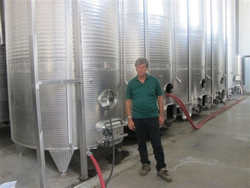 also set up a TT table or another king size bed. ( The 4-room set with full meals can be rented for Rs.50,000 a night, when available).The equipment including the presses, fermentation and storage tanks, the bottling plant, are all imported from Italy. The winery has now a capacity of 700,000 liters, says Piero. also set up a TT table or another king size bed. ( The 4-room set with full meals can be rented for Rs.50,000 a night, when available).The equipment including the presses, fermentation and storage tanks, the bottling plant, are all imported from Italy. The winery has now a capacity of 700,000 liters, says Piero.
One gets the impression that a lot of capital has been sunk into the project-Rs.200 million on the winery alone, says Arjun. As Kapil had explained to me at our office a couple of days earlier, all the partners totally understand and agree that this is a long term project. ‘Quality is of course important but we also wanted to make sure that we maintain the typicity of the grapes which means that the Sangiovese must taste like a Sangiovese only,’ he adds.
Sangioves is the latest grape to hit the market. The wine is quite delicious for the first vintage-dark, spicy, fruity and yet fairly harmonious, slightly rough on the edges. I felt that it would go better with the Indian palate if 5-10% of Merlot or Shiraz were to be added to make it more rounded. But Piero knows what he wants and would be surely experimenting in future to see how he can improve it further.
Tasting what’s in the glass
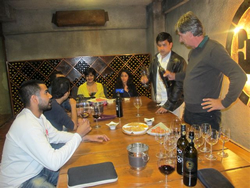 I tasted the complete range of their 8 wines-Classic White (made from second press of juice), Chardonnay-Crisp, and vivacious with a taste of green apples and a juicy end that makes you salivate and ask for more, Chenin –perfumed, dry but fruity and very full on the mouth-feel, Sauvignon Blanc – typical varietal flavours and aromas, vegetal with a touch of asparagus, Classic red- clean, cherry flavours and full on the palate, Sangiovese-earthy flavours, juicy but a bit too astringent and green on the palate, Merlot- juicy with shades of plums and liquorice, ripe tannins, Cabernet Franc Shiraz blend-full of berry flavours, clean and long end-really a trophy winner. But when it came to drinking later in the evening, I found myself continuing with the Chardonnay. I tasted the complete range of their 8 wines-Classic White (made from second press of juice), Chardonnay-Crisp, and vivacious with a taste of green apples and a juicy end that makes you salivate and ask for more, Chenin –perfumed, dry but fruity and very full on the mouth-feel, Sauvignon Blanc – typical varietal flavours and aromas, vegetal with a touch of asparagus, Classic red- clean, cherry flavours and full on the palate, Sangiovese-earthy flavours, juicy but a bit too astringent and green on the palate, Merlot- juicy with shades of plums and liquorice, ripe tannins, Cabernet Franc Shiraz blend-full of berry flavours, clean and long end-really a trophy winner. But when it came to drinking later in the evening, I found myself continuing with the Chardonnay.
Sette uncorked
But it was a real treat to taste the unlabelled ‘Sette’ next morning when Piero uncorked the 2-day old bottle especially for me. I was keen to taste it also because I had read somewhere that their reserve had 15.5% alcohol. 15.5%?! All the wines I had on the previous day had less than 13.5%. Piero was aghast to learn that someone would have written incorrectly without checking the facts. He is quite conscious about keeping alcohol levels under check. Sette had 13.7% measured alcohol at the time of bottling, his lab assistant informs. The wine was still very young- as one could feel the oak vanilla and the juicy tannins.
It might need 2-3 years for showing off its best and will easily last for 5 years. It is supposed to have been in barriques for 12 months but due to the shortage of barriques the new lot of which was expected any day, Piero has done the next best thing-he had taken half the lot and pumped into the stainless steel tank while filling these same French barriques with the other half of the wine. Undoubtedly, Sette will turn out to be a plum of the eye and surely our palate, in the near future. The promoters are keeping the cards close to their chest regarding the pricing or the launch as the quantity is very limited.
Marketing and selling the wine
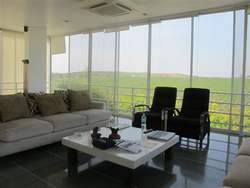 The Classic range has been priced at affordable under Rs.400 but the other wines are priced slightly higher than the brand leader Sula, making it a hump to cross to increase volumes-they go up to Rs.795. The marketing push has been unprecedented with road shows and tasting in all possible venues in the North, especially Delhi. Arjun looks after Western India while Kapil is working in overdrive in Delhi and the North to penetrate the market. The Classic range has been priced at affordable under Rs.400 but the other wines are priced slightly higher than the brand leader Sula, making it a hump to cross to increase volumes-they go up to Rs.795. The marketing push has been unprecedented with road shows and tasting in all possible venues in the North, especially Delhi. Arjun looks after Western India while Kapil is working in overdrive in Delhi and the North to penetrate the market.
Although the visibility has been increasing, especially in Delhi where it entered a couple of months ago, the sales may be lagging the marketing efforts. This is quite understandable as it is only in its second vintage and new brand in the North. Even in Mumbai, ‘the awareness is low and people have started only now asking for Fratelli’, says Arjun. After appointing FineWinesnMore as their distributors for Mahrashtra the company has taken the marketing reins in their own hands and uses them on Mumbai for logistics only. In Delhi, Arizona marketing, a long time former distributor of Sula, has been appointed the distributor and sales have been encouraging, feels Kapil. Haryana will be tapped next year in their efforts to expand pan India.
In the long run, the quality will pay but due to higher prices, especially the wines of the brand leader Sula, the marketing efforts may not translate directly into sales yet. With the higher cost of growing grapes, the break-even is still a few years away and will depend upon how fast they can reach 25,000 cases a year mark, to put them in the upper league. The Classic range is very good value-for-money wine and is expected to get them higher sales for the next couple of years-it has been received well in the market. Sette would be an interesting variant to watch out for-though at low volumes but with high quality and matching prices. The company has been pro-active and taking part in international wine shows and most wine festivals or shows in India, working hard to establish the brand.
As I left the winery, heading back for Pune airport I met the just-arriving Alessio whom I had met a couple of days earlier when he came to meet me in the office with Kapil. He had to stay back in Delhi because there was a tasting at the Delhi Golf Club of which I am an active member. Many of my friends at the club wondered later why I had not been [present at the tasting. Somehow, it felt good to tell them that while over a hundred members were tasting wines at the Club with Alessio, I was busy tasting the complete range at the private and exclusive tasting with the winemaker, viticulturist and a passionate shareholder, Piero Masi in the tasting room at the winery.
For some of the earlier related articles, click
http://www.indianwineacademy.com/item_5_414.aspx
http://www.indianwineacademy.com/item_3_435.aspx
Subhash Arora
Voluntary Disclosure: The visit undertaken on December 17 and 18 was hosted by Fratelli Wines, without any monetary consideration or obligation. The views are personal, but quite independent and objective based on chats with Piero Masi and Arjun at the winery and Kapil and Alessio at our office in Delhi-editor |